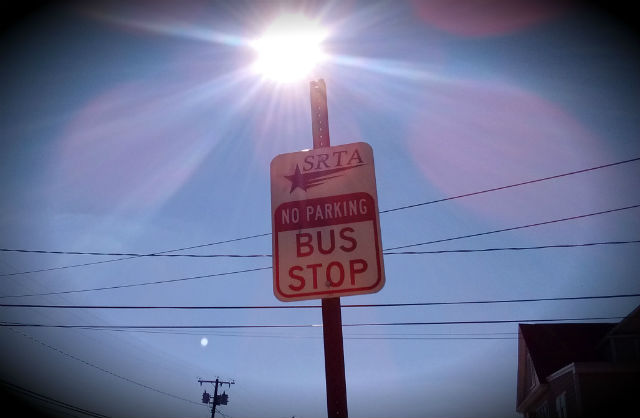Women for SRTA!

Shortly after the Women’s March back in January, this headline caught my eye: Mass transit mobilizes women; why don’t women mobilize for transit?”
The story was on The Atlantic magazine’s CityLab site, and its argument for the headline ran in part, “Women form a disproportionate share of low-wage and hourly workers in the U.S., and across most industries, they earn less on the dollar than men. Those lower wages make many women ‘captive’ transit users, unable to afford a personal vehicle. In single-vehicle households, women are frequently the ones giving up car access and allowing their partners to drive to higher-earning jobs.”
The main thrust of the story was that this was an issue that women could put their political power behind, giving some focus to the energy created by the march.
It caught my eye because – despite some improvement – public transportation is woefully inadequate in New Bedford to meet the needs of a modern economy. No doubt that burden follows the national trend and falls disproportionately on women. But, until recently, a woman was the city and region’s public transportation champion.
Siggy Meilus goes to Washington
That champion was Sigute “Siggy” Meilus. As part of her work at the Community Economic Development Center (CEDC) on Acushnet Avenue, Siggy was the head of Bus Riders United (BRU). In that role, she was successful in gaining a seat on the Southeastern Regional Transportation Authority (SRTA) Advisory Board as a Rider Representative.
SRTA is the region’s only public transportation provider – SouthCoast Rail remaining a distant dream. It was established in 1974 and provides fixed route and demand response bus service to residents of Acushnet, Dartmouth, Fairhaven, Fall River, Freetown, Mattapoisett, New Bedford, Somerset, Swansea, and Westport. It’s funded by a mixture of local, state and federal monies.
As head of BRU, Siggy was a fierce and effective public transportation advocate. Bus Riders United held information sessions and rallies which threw a spotlight on service challenges and opportunities.
New Bedford’s loss was the nation’s gain. Siggy left the CEDC and BRU to accept a position in Washington, D.C. as Executive Director for Americans for Transit, a non-profit that works to strengthen grassroots movements for better public transit. Siggy didn’t need to read the CityLab article; she’s living it.
The Good, the Bad and the Ugly of SRTA
She leaves behind those SRTA challenges and opportunities, however. Before Siggy left New Bedford for Americans for Transit, we met to discuss the good, the bad and the ugly of SRTA service. We both agreed that of great importance was finding a person or persons to fill her position on the Advisory Board and also keep BRU alive. Both provide critical oversight as to how funds are spent on transit needs. Indeed, both help identify those needs.
The complexity of financing and expanding SRTA service is beyond the scope of this column. Anyone who has experienced a modern public transit system understands that evening service needs to be expanded within and without New Bedford and Sunday service added. Too much of SRTA service ends around 6:00pm and Sunday service is now nonexistent – which hardly meets the demands of a retail and service-orientated economy.
Some recent positive momentum has been achieved at the agency – as outlined in this Standard-Times feature – but my personal feeling is that SRTA is one of those quasi-governmental entities that could do a lot more by simply shaking off the cobwebs and thinking outside the box – as so many of us do every day here at Groundwork!
Branding SRTA
For example, SRTA recently missed the bus with a huge branding opportunity. A couple of years ago, signs at all the bus stops were switched out for new ones.
Away went the old SRTA logo – so old it was groovy again in a retro sort of way. Up went SRTA’s new logo – which looks like something an under-performing marketing intern created in Microsoft Word 2.0.
A public transportation system helps brand an entire city. Done right, it can help instill civic pride in a place by helping it form a distinct identity. SRTA’s generic bus stop signs and awful logo convey none of that and carry no necessary information – such as route numbers – which would make them both a welcome addition to New Bedford’s neighborhoods as well as a wise as opposed to wasted expenditure.
I could go on for another 800 words with more simple suggestions which wouldn’t represent a budget dilemma but illustrate some creative thinking. More than anything, that may be what’s necessary to propel SRTA into a future that fulfills the promise of effective mass transit for everybody.
A good start may be by putting the power of “pushy women” – as my colleague, Groundwork! co-founder Sarah Athanas, calls them – to work on the problem.
I’m certain Siggy Meilus would still be glad to help!
- A Pride month to be proud of in New Bedford - May 30, 2019
- OUTTAKE: Inside the First Baptist Church renovation - May 2, 2019
- New Bedford Economic Development Council’s Spring Fling - April 30, 2019
